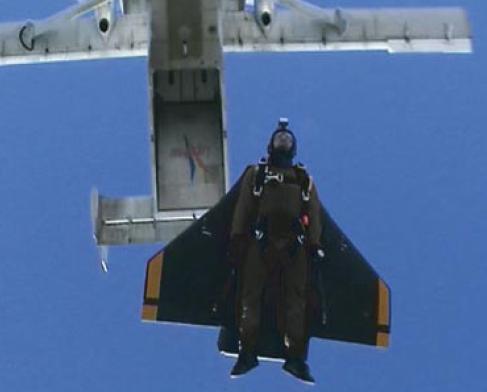Like most kids, when I was young I used to dream about flying around in the clouds. Daydreaming in geography, or around mountains in deep sleep, it was always something I wanted to do. I would still love to. I even did a tandem, and I think I would get AFF certified if it weren't for the near $1000 pricetag. But for a rare few neither any amount of money, nor being told to be realistic and stop dreaming can keep them from the dream of human flight.
First there are wingsuit pilots. Made popular by BASE jumpers in Norway, Switzerland, Sweden, and other Alpine nations, Wingsuits are pretty much the closest thing to human flight without aid. There is, of course, aid. A ripstop nylon suit to give the jumper area to get lift, and a 'chute. But it has to be the most intuitive way to take to the skies once parachuting and BASE jumping are natural.These cats are about the best in the world right now:
Then there are the folks who think a rigid wing cat be more efficient in lift capability, producing longer flights. About 3 years ago, Felix Baumgartner flew across the English Channel in a redbull sponsored rigid frame backpack wing. he jumped from about 30,000 ft, and soared 35 km, or 22 miles in 6 and a half minutes. He hit 200 km/hr, that's damn quick. Article here. There is also a version that is newer, and developed for Military use. It was made by a company called Spelco which makes parachutes and the like for the German armed forces. Their version is called the Gryphon, and has had limited testing. They think that eventually they will be able to fit it with missiles and even mini jet engines, so it could become a major ass-kicking machine in the near future, but for now, no military has "officially" funded, or purchased the technology or the rights to produce. Article Here.
There is also a version that is newer, and developed for Military use. It was made by a company called Spelco which makes parachutes and the like for the German armed forces. Their version is called the Gryphon, and has had limited testing. They think that eventually they will be able to fit it with missiles and even mini jet engines, so it could become a major ass-kicking machine in the near future, but for now, no military has "officially" funded, or purchased the technology or the rights to produce. Article Here.
Monday, October 29, 2007
Science of Flight for Fight of Science
Posted by
Wormocious: Bodhisattva of Nanoemotions
at
4:22 PM
![]()
Subscribe to:
Post Comments (Atom)


No comments:
Post a Comment